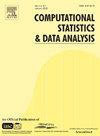基于模型的基于惩罚Wishart混合模型的协方差矩阵聚类
IF 1.6
3区 数学
Q3 COMPUTER SCIENCE, INTERDISCIPLINARY APPLICATIONS
引用次数: 0
摘要
协方差矩阵提供了有关数据中复杂交互和依赖关系的有价值的信息源。然而,从集群的角度来看,这些信息往往没有得到充分利用和忽视。事实上,通常采用的基于距离的方法往往主要依赖于平均水平来表征和区分群体。最近,直接聚类协方差矩阵,从而仅根据变量之间的关系来区分组,已经有了很有希望的努力。从基于模型的角度来看,通过考虑组件密度遵循Wishart分布的混合模型,提供了概率形式化。然而,这种方法在处理大量变量时面临挑战,因为要估计的参数数量呈二次增长。为了解决这一问题,提出了一种稀疏的Wishart混合模型,该模型假设组件尺度矩阵具有簇依赖的稀疏度。模型估计是通过最大化惩罚对数似然来执行的,在分量尺度矩阵上强制执行协方差图形套索惩罚。这种惩罚不仅减少了非零参数的数量,减轻了高维设置的挑战,而且通过强调变量之间最相关的关系,增强了结果的可解释性。所提出的方法在模拟和真实数据上进行了测试,证明了它能够揭示神经成像数据的复杂性,并根据不同大脑区域之间的关系模式有效地聚类受试者。本文章由计算机程序翻译,如有差异,请以英文原文为准。
Model-based clustering for covariance matrices via penalized Wishart mixture models
Covariance matrices provide a valuable source of information about complex interactions and dependencies within the data. However, from a clustering perspective, this information has often been underutilized and overlooked. Indeed, commonly adopted distance-based approaches tend to rely primarily on mean levels to characterize and differentiate between groups. Recently, there have been promising efforts to cluster covariance matrices directly, thereby distinguishing groups solely based on the relationships between variables. From a model-based perspective, a probabilistic formalization has been provided by considering a mixture model with component densities following a Wishart distribution. Notwithstanding, this approach faces challenges when dealing with a large number of variables, as the number of parameters to be estimated increases quadratically. To address this issue, a sparse Wishart mixture model is proposed, which assumes that the component scale matrices possess a cluster-dependent degree of sparsity. Model estimation is performed by maximizing a penalized log-likelihood, enforcing a covariance graphical lasso penalty on the component scale matrices. This penalty not only reduces the number of non-zero parameters, mitigating the challenges of high-dimensional settings, but also enhances the interpretability of results by emphasizing the most relevant relationships among variables. The proposed methodology is tested on both simulated and real data, demonstrating its ability to unravel the complexities of neuroimaging data and effectively cluster subjects based on the relational patterns among distinct brain regions.
求助全文
通过发布文献求助,成功后即可免费获取论文全文。
去求助
来源期刊

Computational Statistics & Data Analysis
数学-计算机:跨学科应用
CiteScore
3.70
自引率
5.60%
发文量
167
审稿时长
60 days
期刊介绍:
Computational Statistics and Data Analysis (CSDA), an Official Publication of the network Computational and Methodological Statistics (CMStatistics) and of the International Association for Statistical Computing (IASC), is an international journal dedicated to the dissemination of methodological research and applications in the areas of computational statistics and data analysis. The journal consists of four refereed sections which are divided into the following subject areas:
I) Computational Statistics - Manuscripts dealing with: 1) the explicit impact of computers on statistical methodology (e.g., Bayesian computing, bioinformatics,computer graphics, computer intensive inferential methods, data exploration, data mining, expert systems, heuristics, knowledge based systems, machine learning, neural networks, numerical and optimization methods, parallel computing, statistical databases, statistical systems), and 2) the development, evaluation and validation of statistical software and algorithms. Software and algorithms can be submitted with manuscripts and will be stored together with the online article.
II) Statistical Methodology for Data Analysis - Manuscripts dealing with novel and original data analytical strategies and methodologies applied in biostatistics (design and analytic methods for clinical trials, epidemiological studies, statistical genetics, or genetic/environmental interactions), chemometrics, classification, data exploration, density estimation, design of experiments, environmetrics, education, image analysis, marketing, model free data exploration, pattern recognition, psychometrics, statistical physics, image processing, robust procedures.
[...]
III) Special Applications - [...]
IV) Annals of Statistical Data Science [...]
 求助内容:
求助内容: 应助结果提醒方式:
应助结果提醒方式:


